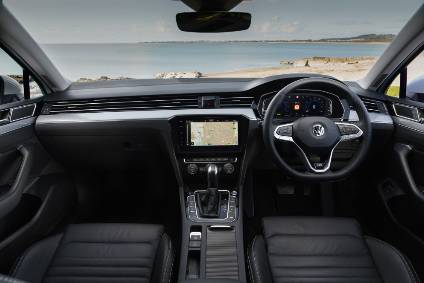
The face-lifted eighth-generation Volkswagen Passat offers higher levels of driver assistance and comfort. Continuing just-auto/QUBE's review of interior design and technology trends, we take a closer look inside to see how it compares to its reassuringly solid and safe predecessor.
First impressions
At first glance, the front and rear bumpers, headlights and radiator grille have all been tweaked. Added inside are new trim finishes, colour and fabrics, redesigned door trims and fresh-looking instruments. A Passat logo in the centre of the dash replaces an analogue clock. The often-used buttons and dials on the centre console are easy to reach and fiddle with. It all makes sense.
In terms of trim level, the Passat range has been simplified with eight variants offered, namely: SE, SE Nav, SEL, R-Line and limited-run, Estate-only, R-Line Edition, alongside the Alltrack, GTE and GTE Advance. The SEL estate that we took out and about last week featured lots of driver comfort, including 14-way powered, leather front seats with seat massage. The heated steering wheel also made it a pleasure to drive on some chilly days.
Infotainment
The cockpit features the carmaker's latest-generation infotainment system, itself based on the brand's Modular Infotainment Matrix (MIB). A notable feature is the connectivity unit including integrated eSIM. This enables the car to be permanently online. Its digital instruments have been enhanced compared with the previous system.

US Tariffs are shifting - will you react or anticipate?
Don’t let policy changes catch you off guard. Stay proactive with real-time data and expert analysis.
By GlobalDataThe 11.7-inch reconfigurable instrumentation cluster provides better graphic performance, greater pixel density, improved brightness and contrast alongside more intense colours. The driver can also switch between three basic layouts via a button on the steering wheel.
Voice recognition
Voice recognition is seen by some as the answer to eliminate many controls that have traditionally been manually operated. Voice can play an important part of a multimodal HMI solution for inputting information or for cutting through layers on the menus by requesting a function directly. Traditional voice control was centred on a set of fixed commands with catatonic responses which required some level of driver training prior to operation of the system. With the advent of the new low power, high performance microprocessors, smarter voice command engines linked into the HMI logic are now available. Even natural language and grammatical analysis are becoming more achievable.
Voice recognition looks set to play a bigger role as cars gradually become more autonomous. In the latest Passat, all major features for navigation, telephone and radio can be operated using speech. It needs to hear "Hello Volkswagen" before each request. This kind of natural voice control is possible because the input voice signals are processed and recognised via the cloud, thanks to the car's built-in eSIM. Voice control also works offline, albeit in a simpler mode.
Advanced driver assistance systems
The Society of Automotive Engineers (SAE) defines five levels of driving automation, ranging from 'no automation' (you do all the work, level zero) to 'full automation' (level 5). A key distinction is between level 2, where you perform part of the dynamic driving task, and level 3, where the automated driving system performs the entire dynamic driving task for you. These automated driving levels are also referred to feet off, hands-off, eyes off and ultimately brain off.
In terms of semi-autonomous driving technologies, the Passat ticks a number of boxes. The umbrella brand for the carmaker's driver assist systems is known as IQ.DRIVE. The suite of advanced driver assistance system (ADAS) technologies on the Passat includes Travel Assist, making it the first VW that can drive at up to 130 mph in a partially automated mode (ideal for the German autobahn then). It is an amalgamation of adaptive cruise control (ACC) and Lane Assist. The model has a radar sensor in the lower grille for adaptive cruise control, forward collision warning and autonomous electronic braking. It also features side radar sensors for 'side scan lane change assist'.
The carmaker's third and latest generation ACC function is now predictive and so can automatically adjust speed for permanent and temporary speed limits, as well as slowing for junctions and corners. It is fed by both GPS and road sign recognition.
The Passat marks the first brand model worldwide with a capacitive steering wheel. The capacitive surface recognises that the driver is still controlling the vehicle by means of hands-off detection. In the past, feedback was required from the driver in the form of a slight movement of the steering wheel. If the driver lets go of the steering wheel for more than around 10 seconds, then a series of warning signals (visual, acoustic, braking jolt) are issued. The driver must react by this point at the latest and touch the steering wheel, otherwise Emergency Assist is activated and the vehicle is automatically brought to a stop.
On the road
Without question, the Passat is the same solid and unpretentious model. For all the development work on the seating and clever packaging, the driving position remains good with more than enough leg space in the back for six-footers. The cabin is a pleasure to sit in with a wrap-around, uncluttered cockpit with 'cross hatch' decorative inserts in the dash, centre console and door panels.
Last year, Volkswagen sold 12,444 Passats in the UK alone. It competes in the B-segment saloon and estate class, a rival to the likes of Volvo S60/V60, BMW 3 Series and Ford Mondeo. For the record, the B-segment occupied 6.3% of the UK market in 2018, with sales in the segment split 75% fleet and 25 % retail. The fleet/retail split of the enhanced Passat is anticipated to be 68 % fleet/32% retail. The Passat is built at VW's Emden plant in Germany.



